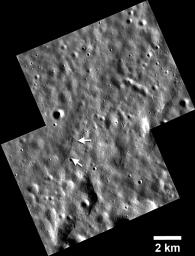
|
Little Scarp has Big Implications
- Click the image above for a larger view
- Full-Res JPEG (1800 x 2369) (364.7 kB)
- Full-Res TIFF (1800 x 2369) (4.3 MB)
Caption:
New images obtained during low-altitude opportunities when the MESSENGER spacecraft is closest to the surface have revealed a small lobate scarp , identified here with white arrows. Cooling of Mercury's interior over billions of years has caused the planet to contract, forming a network of large landforms called lobate scarps, many over a kilometer high and hundreds of kilometers long. One of the goals for MESSENGER's current extended mission is to determine if there is evidence of young fault scarps that indicate recent contraction of Mercury due to interior cooling and continued solidification of the core. This scarp is only 2 km long, the shortest fault scarp yet found on Mercury. Landforms of this scale must be young, because small features will not survive for billions of years under constant meteoroid bombardment. Lobate scarps of the same scale found on the Moon are thought to be no more than 800 million years old and could be less than 50 million years old. Thus, this small scarp and others likely to be discovered in low-altitude images could provide evidence of very recent contraction of Mercury.
This image was acquired as a high-resolution targeted observation. Targeted observations are images of a small area on Mercury's surface at resolutions much better than that of the 200-meter/pixel morphology base map. It is not possible to cover all of Mercury's surface at this high resolution, but typically several areas of high scientific interest are imaged in this mode each week.
Date acquired:
February 09, 2014
Image Mission Elapsed Time (MET):
34263837, 34263839
Image ID:
5729947, 5729948
Instrument:
Narrow Angle Camera (NAC) of the Mercury Dual Imaging System (MDIS)
Center Latitude:
65.8°
Center Longitude:
64.8° E
Resolution:
17 meters/pixel
Scale:
2-kilometer (1.2-mile) scale bar shown on the image
Incidence Angle:
79.7°
Emission Angle:
33.5°
Phase Angle:
113.3°
Background Info:
The MESSENGER spacecraft is the first ever to orbit the planet Mercury, and the spacecraft's seven scientific instruments and radio science investigation are unraveling the history and evolution of the Solar System's innermost planet. MESSENGER acquired over 150,000 images and extensive other data sets. MESSENGER is capable of continuing orbital operations until early 2015.
For information regarding the use of images, see the MESSENGER image use policy .
Cataloging Keywords:
| Name | Value | Additional Values |
|---|---|---|
| Target | Mercury | |
| System | ||
| Target Type | Planet | |
| Mission | MESSENGER | |
| Instrument Host | MESSENGER | |
| Host Type | Orbiter | |
| Instrument | Mercury Dual Imaging System (MDIS) | |
| Detector | Narrow Angle Camera (NAC) | |
| Extra Keywords | Grayscale, Map, Moon, Radio | |
| Acquisition Date | ||
| Release Date | 2014-03-17 | |
| Date in Caption | 2014-02-09 | |
| Image Credit | NASA/Johns Hopkins University Applied Physics Laboratory/Carnegie Institution of Washington | |
| Source | photojournal.jpl.nasa.gov/catalog/PIA18124 | |
| Identifier | PIA18124 | |
